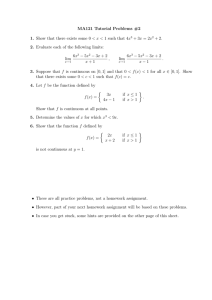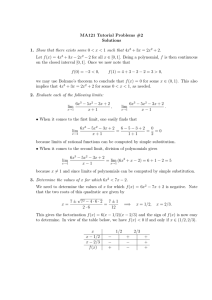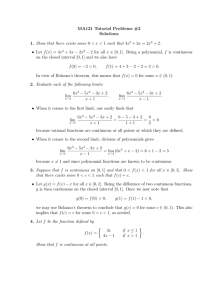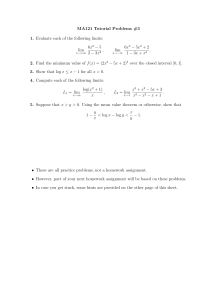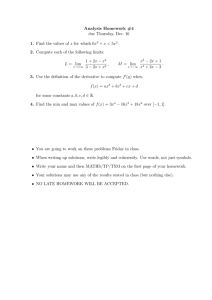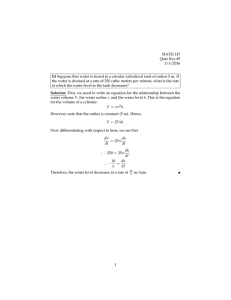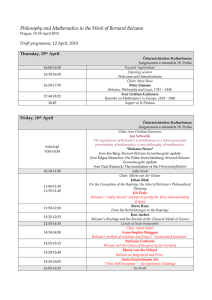MA121 Tutorial Problems #2 < x < x + 2.
advertisement
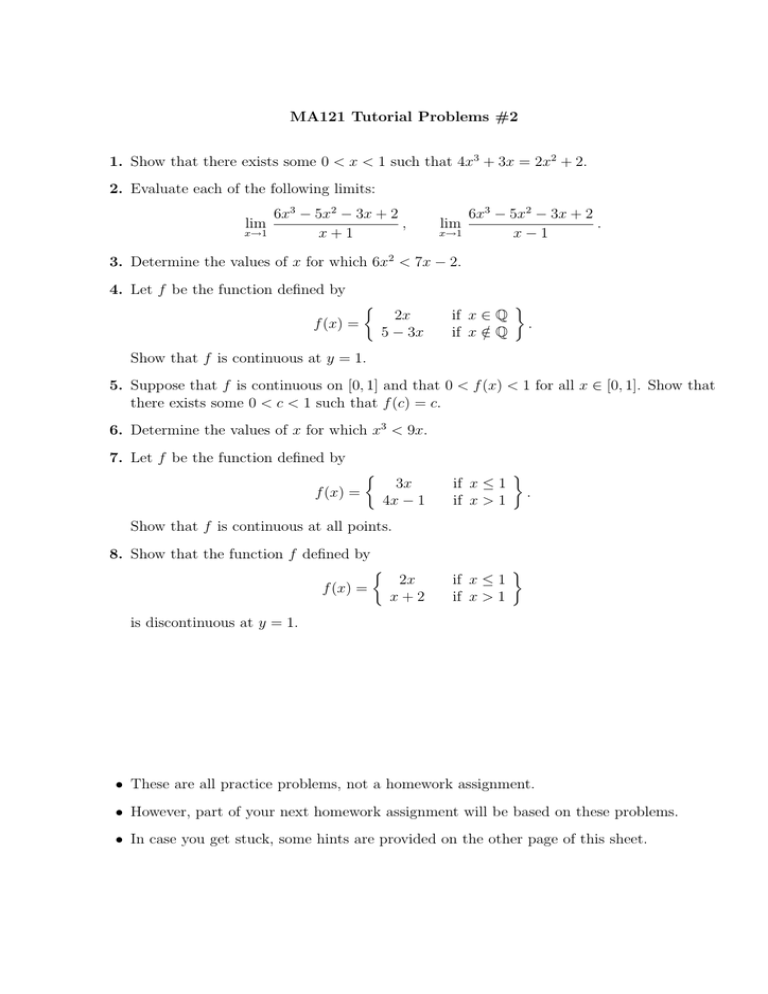
MA121 Tutorial Problems #2 1. Show that there exists some 0 < x < 1 such that 4x3 + 3x = 2x2 + 2. 2. Evaluate each of the following limits: lim x→1 6x3 − 5x2 − 3x + 2 , x+1 lim x→1 6x3 − 5x2 − 3x + 2 . x−1 3. Determine the values of x for which 6x2 < 7x − 2. 4. Let f be the function defined by ½ f (x) = 2x 5 − 3x if x ∈ Q if x ∈ /Q ¾ . Show that f is continuous at y = 1. 5. Suppose that f is continuous on [0, 1] and that 0 < f (x) < 1 for all x ∈ [0, 1]. Show that there exists some 0 < c < 1 such that f (c) = c. 6. Determine the values of x for which x3 < 9x. 7. Let f be the function defined by ½ f (x) = 3x 4x − 1 if x ≤ 1 if x > 1 ¾ . Show that f is continuous at all points. 8. Show that the function f defined by f (x) = ½ 2x x+2 if x ≤ 1 if x > 1 ¾ is discontinuous at y = 1. • These are all practice problems, not a homework assignment. • However, part of your next homework assignment will be based on these problems. • In case you get stuck, some hints are provided on the other page of this sheet. Some hints 1. You need f (x) = 4x3 + 3x − 2x2 − 2 to have a root in (0, 1). Since f is continuous on the closed interval [0, 1], you can apply Bolzano’s theorem. 2. For the first limit, one can substitute x = 1 because rational functions are continuous wherever they are defined. For the second limit, you will need to simplify the fraction (using division of polynomials) before you can actually substitute. 3. You need to find the values of x for which 6x2 − 7x + 2 < 0. Determine the roots of the quadratic and then factor. 4. You did something similar in your last homework. Let ε > 0 be given and note that ½ ¾ 2|x − 1| if x ∈ Q |f (x) − f (1)| = |f (x) − 2| = . 3|1 − x| if x ∈ /Q You need to find some δ > 0 such that |x − 1| < δ =⇒ |f (x) − f (1)| < ε. 5. You need the function g(x) = f (x) − x to have a root in (0, 1). Argue that this function is continuous on the closed interval [0, 1] and then use Bolzano’s theorem. 6. Move everything on the left hand side and factor: x3 < 9x ⇐⇒ x(x − 3)(x + 3) < 0. 7. In case you have your notes with you, Example 2.13 is quite similar. Continuity on the open interval (−∞, 1) follows by a lemma of ours, and so does continuity on (1, ∞). It thus remains to check continuity at y = 1; use the ε-δ definition to do that. 8. Suppose f is continuous at y = 1. Then there exists some δ > 0 such that |x − 1| < δ =⇒ |f (x) − 2| < 1. In other words, there exists some δ > 0 such that 1−δ <x<1+δ =⇒ 1 < f (x) < 3. Now, look at the point x = 1 + δ/2 to see that this is a contradiction. • The intuition behind the argument above: when x ≈ 1, we have 2x ≈ 2 and x + 2 ≈ 3, so the graph of f has a jump of length 1 near y = 1. Thus, the ε-δ definition of continuity is not expected to hold when ε = 1.
